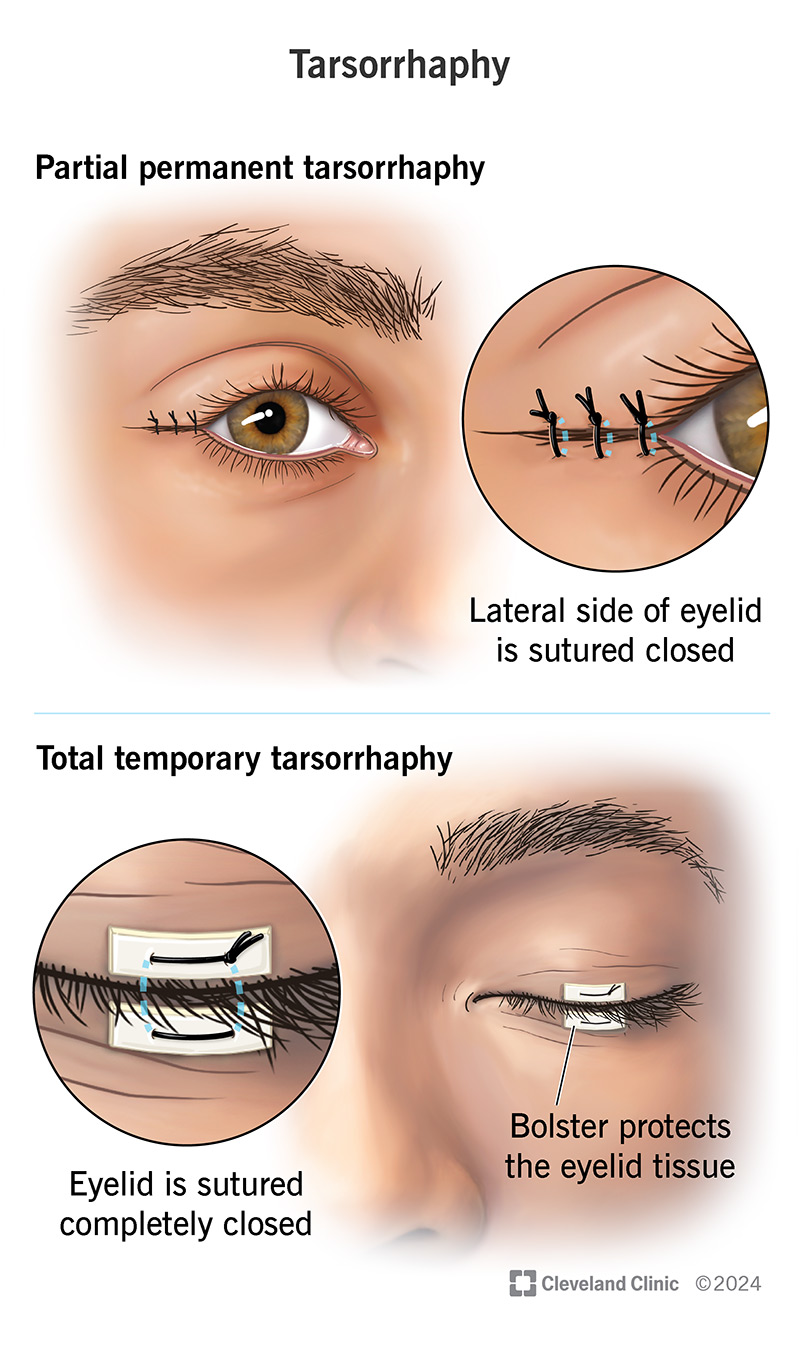Tarsorrhaphy is a medical treatment that keeps your eyes closed. When used as a treatment, it creates a safe environment that’s ideal for eye healing. It can also be part of efforts to restore facial appearance differences from medical conditions and treatments or injuries. It’s usually temporary but can last from weeks to years.
Advertisement
Cleveland Clinic is a non-profit academic medical center. Advertising on our site helps support our mission. We do not endorse non-Cleveland Clinic products or services. Policy

Tarsorrhaphy is a medical procedure that involves keeping your eyes shut for longer periods. Like a cast holds a broken arm or leg in place while it heals, tarsorrhaphy helps hold your eyelids in place. Tarsorrhaphy is usually unilateral, meaning only done on one eye. But your provider can do it on both sides if necessary.
Advertisement
Cleveland Clinic is a non-profit academic medical center. Advertising on our site helps support our mission. We do not endorse non-Cleveland Clinic products or services. Policy
Closing your eyelids can help with several different conditions and issues. But tarsorrhaphy (pronounced “tar-SORE-oh-fee”) is mainly for keeping your eyelids shut to prevent further injuries and issues on your eyes’ surface.
Tarsorrhaphy combines two Ancient Greek words that mean “foot” and “to sew.” The “foot,” in this case, is the foot of your eyelid, the lower edge where your upper eyelid can seal against your lower eyelid. And while tarsorrhaphy may involve sewing stitches (sutures) to close your eyelids, there are also several other ways to get the same effect without stitches.
There are a few different factors that your eye care specialist or other provider can consider when deciding which form of tarsorrhaphy can help you best.
Tarsorrhaphies keep your eyes closed for extended periods. That can mean any of the following:
Advertisement
Tarsorrhaphies can vary depending on how much your eye needs to close. Some of the different ways that can work are:
Tarsorrhaphies can involve a few different methods. They include:
Tarsorrhaphy has several uses. Sometimes, it’s a treatment for a condition or issue that already happened. Other times, it’s a preventive measure to avoid future complications.
Tarsorrhaphy can be a very helpful treatment when you have a condition that affects your eye surface or are at risk for eye surface issues. Examples include:
If your eye shape or position changes, it can be harder to close your eyes properly. Not being able to close one or both eyes is called lagophthalmos (pronounced “lag-op-ff-THALM-oh-ss”). Conditions that can cause this include:
Advertisement
Conditions that affect your eyelid movement, placement or control can affect how your eyes close. Examples of these conditions include:
Tarsorrhaphy has a number of advantages:
Tarsorrhaphy has a few disadvantages or reasons why it might not help. They include:
Advertisement
If tarsorrhaphy involves sutures or surgery, your eye care specialist or other provider will use topical medications to numb your skin so the procedure doesn’t hurt. After the procedure, your specialist may prescribe medications for pain. But you may not need any medications or may only need over-the-counter medications like acetaminophen or nonsteroidal anti-inflammatory drugs (NSAIDs).
Your eye specialist or other provider can tell you more about what to expect and how to manage any pain or discomfort.
In cases where tarsorrhaphy should be temporary, the time it’ll last can vary. Your eye care specialist will tell you if they need to do follow-up checks to assess your eye health and recovery. Those follow-ups will be key in determining if and when to reverse the tarsorrhaphy and let you go back to using the affected eye.
After tarsorrhaphy, there are some important things you can do to help your odds of a favorable outcome.
Advertisement
In addition to seeing your provider as recommended, you should call or see your provider if you notice any of the following:
Having tarsorrhaphy to keep one or both eyes shut isn’t something anyone wants, and facing that possibility can be scary or frustrating. But one reason why this procedure is an important treatment option is because it has an extremely high success rate. It can also help with many conditions and issues. Your eye care specialist or other provider can explain if tarsorrhaphy is likely to help and the options they recommend for your specific case and needs.
Cleveland Clinic’s ophthalmologists and optometrists have the highest training available. We provide exams, vision correction and care for many eye conditions.

Last reviewed on 12/23/2024.
Learn more about the Health Library and our editorial process.